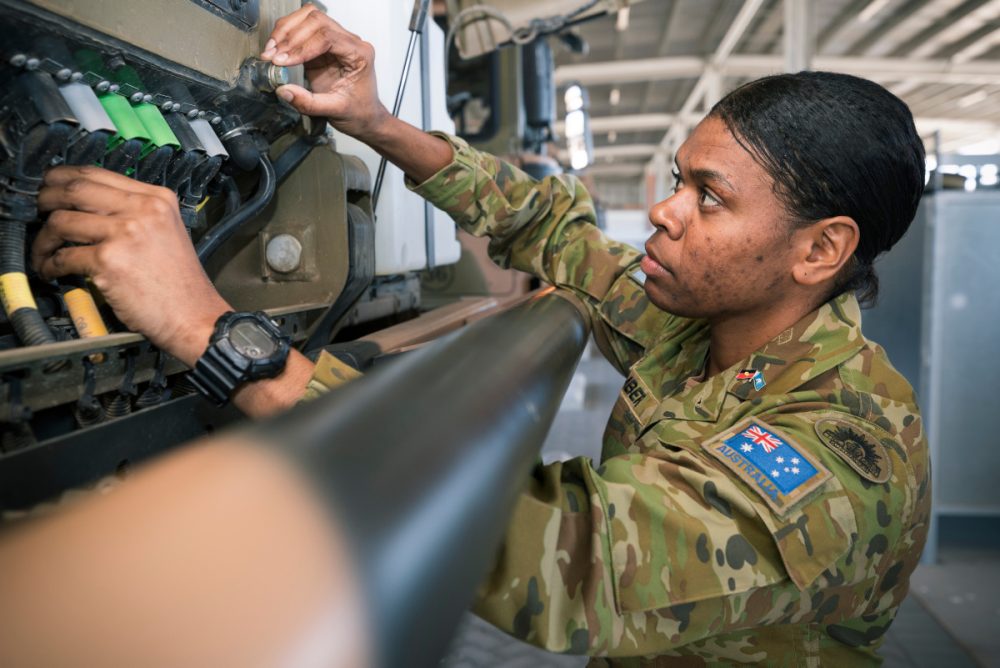
It isn’t news that diverse workforces are a key to producing high-quality, innovative and competitive results. There’s no shortage of evidence from both the private and public sectors that diverse teams solve problems more effectively, think more creatively and are better for the bottom line than their homogenous counterparts.
In 2019, the chief of the Australian Defence Force, General Angus Campbell, set his sights on increasing Aboriginal and Torres Strait Islander representation in the ADF. He said that he wanted 5% of the ADF to be Indigenous Australians, ‘bringing heritage, bringing diversity, bringing insights, bringing perspective that we cannot otherwise realise’.
Aboriginal and Torres Strait Islander people have a long history of employment in the ADF, using their skills, languages, cultures and knowledge of the land in the defence of Australia. Indigenous Australians have participated in the armed forces since before federation—which is remarkable given the brutal and violent history between the white settlers and Aboriginal Australians.
More recently, Aboriginal and Torres Strait Islander people have been involved in ADF units such as the North-West Mobile Force (or Norforce, as it’s more commonly known). That model should be replicated across the ADF to increase the number of Indigenous Australians in defence and to expand their impact. This approach could help establish pathways to progress Indigenous Australians’ careers from recruitment to promotion through the ranks, and ultimately to levels as high as defence force chief.
The Northern Territory has a high percentage of Indigenous Australians living in both urban and rural settings. The ADF has an opportunity to fill an increasing skills gap in the territory by recruiting reservists, permanent members of the ADF, Defence officials and employees of defence industry. Darwin and Katherine are two major northern centres in which the ADF could focus its recruitment activity.
The ADF also has the opportunity to involve a new generation of experts in science, technology engineering and maths from under-represented groups. The 2018 NT defence and national security strategy calls for adding high-tech platforms in the region to enable the territory to be nationally competitive, agile and on the forefront of new technological advances for defence. In 2018, the NT government’s cyber awareness program was digitised and expanded to include ‘a focus on improving opportunities for the business community to participate in the Defence supply chain’.
Improving the participation of women in the ADF is likewise crucial to filling its skills gaps. The involvement of women from all cultural backgrounds has been found to increase capability in the ADF. Increasing the number of women in the cyber workforce is crucial.
The 2017–18 report on women in the ADF noted that recruiting more women was crucial to ensuring that the ADF secures the best possible talent. At that time, women made up 17.9% of the total ADF. Women’s participation has improved considerably in the past decade and they now make up 21.5% of the navy, 14.3% of the army and 22.1% of the air force. Defence is aiming for female participation to reach 25% in the navy, 15% in the army and 25% in the air force by 2023.
Aboriginal and Torres Strait Islander peoples bring diverse skills that are vital to the defence of Australia’s north, including unmatched, specific knowledge in areas that aren’t taught in classrooms.
Communities in this region understand how to work in extreme climatic conditions and have crucial skills in reconnaissance, observation and collection of military geographic intelligence. The 2016 defence white paper and accompanying investment program identified infrastructure investment, in particular for cyber capabilities at defence sites in Darwin and in the Katherine region, as a high priority.
Many Aboriginal people in the NT are expert linguists, sometimes speaking more than eight languages. These skills can be transferred to fields like cybersecurity to help meet the NT’s increasing need for people who are proficient in coding languages.
Since the introduction of the Indigenous procurement policy in 2015, there’s been no shortage of Indigenous businesses that Defence can contract to in the territory.
Drawing on these resources makes good sense, and the timing is perfect. As argued last year, involving Aboriginal and Torres Strait Islander communities in Defence’s work in the north will provide economic and security benefits to the region and ensure that Indigenous Australians can participate in the global economy.
There is still a long way to go. Attracting women and people from culturally diverse backgrounds to the ADF is notoriously difficult. It requires a rethink of how the ADF operates, including its approach to flexible working arrangements, to ensure it provides a safe and accepting environment.
That won’t be easy, but it is absolutely in Australia’s interests.

